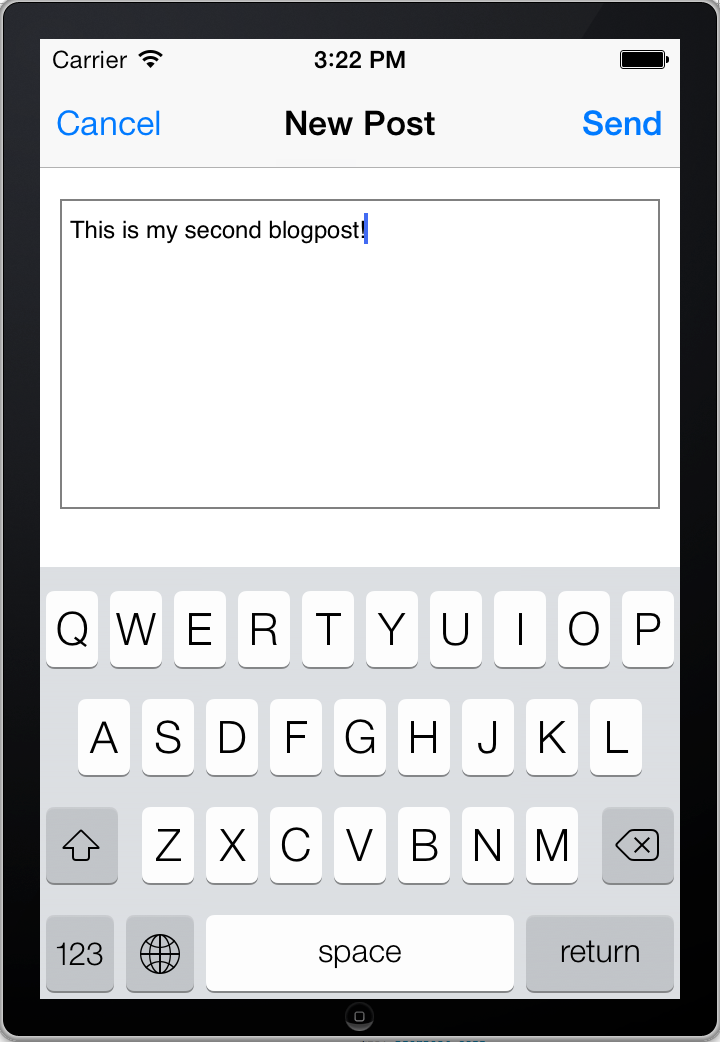Create new Posts in Frontend¶
In the last chapter we created an iOS app which shows all the blogposts. Now let’s see how we use the API to create new blogposts.
Update RestKit setUp¶
First of all define how RestKit will post BlogPosts and how the response data must be deserialized. To do this add a response and a request descriptor for POST Requests to /blogposts in the setUpRestKit method, which we defined earlier in the AppDelegate:
RKResponseDescriptor* blogPostPostResponse = [RKResponseDescriptor responseDescriptorWithMapping:[BlogPost mapping]
method:RKRequestMethodPOST
pathPattern:@"/blogposts"
keyPath:nil
statusCodes:statusCodes];
RKRequestDescriptor* blogPostPostRequest = [RKRequestDescriptor requestDescriptorWithMapping:[[BlogPost mapping] inverseMapping]
objectClass:[BlogPost class]
rootKeyPath:nil
method:RKRequestMethodPOST];
[manager addResponseDescriptorsFromArray:@[blogPostGetResponse, blogPostPostResponse]];
[manager addRequestDescriptor:blogPostPostRequest];
Response Descriptor¶
To create a new blogpost a BlogPost object must be posted to the /blogposts endpoint. The returned data is the created blogpost in json format. So the response descriptor looks like the response descriptor we used for the GET request, but we don’t configure a keyPath, because the returned blogpost is not nested in data.blogposts.
Request Descriptor¶
The request descriptor defines that the inverse blogpost mapping is used if a BlogPost object is posted to any endpoint.
The View¶
To create a new BlogPost we will show a modal view with an UITextView and a hideable errorLabel.
This is the interface:
#import <UIKit/UIKit.h>
@interface CreateBlogPostView : UIView
@property(nonatomic, strong)UITextView* textView;
-(void)showError:(NSString*)error;
-(void)hideError;
@end
Here you can find a possible implementation for the view.
The View Controller¶
CreateBlogPostViewController.h:
#import <UIKit/UIKit.h>
@protocol CreateBlogPostDelegate;
@interface CreateBlogPostViewController : UIViewController <UITextViewDelegate>
@property (nonatomic, weak) id<CreateBlogPostDelegate> delegate;
@end
@protocol CreateBlogPostDelegate <NSObject>
- (void)dismissCreateBlogPost;
@end
CreateBlogPostViewController.m:
@interface CreateBlogPostViewController ()
- (void)sendPost:(id)sender;
- (void)dismiss:(id)sender;
@end
@implementation CreateBlogPostViewController
- (id)initWithNibName:(NSString *)nibNameOrNil bundle:(NSBundle *)nibBundleOrNil
{
self = [super initWithNibName:nibNameOrNil bundle:nibBundleOrNil];
if (self) {
// this is necessary for ios 7, else editing would start in the middle of
// the textView
self.automaticallyAdjustsScrollViewInsets = NO;
self.navigationItem.title = @"New Post";
self.navigationItem.rightBarButtonItem = [[UIBarButtonItem alloc] initWithTitle:@"Send"
style:UIBarButtonItemStyleDone
target:self
action:@selector(sendPost:)];
self.navigationItem.leftBarButtonItem = [[UIBarButtonItem alloc] initWithTitle:@"Cancel"
style:UIBarButtonItemStylePlain
target:self
action:@selector(dismiss:)];
[self.navigationItem.rightBarButtonItem setEnabled:NO];
}
return self;
}
- (void)loadView {
CreateBlogPostView* createBlogPostView = [[CreateBlogPostView alloc] initWithFrame:[[UIScreen mainScreen] applicationFrame]];
[createBlogPostView.textView setDelegate:self];
self.view = createBlogPostView;
}
- (void)sendPost:(id)sender {
BlogPost* post = [[BlogPost alloc] init];
post.text = [(CreateBlogPostView*)self.view textView].text;
[[RKObjectManager sharedManager] postObject:post
path:@"/blogposts"
parameters:nil
success:^(RKObjectRequestOperation *operation, RKMappingResult *mappingResult) {
[self dismiss:nil];
} failure:^(RKObjectRequestOperation *operation, NSError *error) {
[(CreateBlogPostView*)self.view showError:@"An error occured, please try again later."];
}];
}
-(void)textViewDidChange:(UITextView *)textView {
[self.navigationItem.rightBarButtonItem setEnabled:textView.text.length > 0];
}
- (void)dismiss:(id)sender {
[self.delegate dismissCreateBlogPost];
}
@end
CreateBlogPostDelegate¶
Because the CreateBlogPostViewController will be presented modal, we define an interface with a method to dismiss the controller. The delegate has to implement that.
Initialization¶
The initialization code just adds two buttons to the navigation bar. We disable the Send button because the textView is empty in the beginning and we don’t want the user to send an empty post.
Load View¶
The loadView initializes the view and sets the controller itself as the textViews delegate, so the controller realizes if the text changes and is able to enable the sendbutton, if the textView is not empty anymore (textViewDidChange).
Send Post¶
Within the sendPost method a BlogPost is created and the textViews’s text is assigned as a text property. Then the newly created object is sent to the /blogposts endpoint. If something goes wrong, the views showError: method is used to show an error message, else the controller is dismissed.
Present the ViewController¶
Open the TimeLineViewController and add two methods to present and dismiss the controller:
- (void)createNewBlogPost:(id)sender {
CreateBlogPostViewController* blogPostController = [[CreateBlogPostViewController alloc] initWithNibName:nil bundle:nil];
[blogPostController setDelegate:self];
UINavigationController* blogPostNavigationController = [[UINavigationController alloc] initWithRootViewController:blogPostController];
[self presentViewController:blogPostNavigationController animated:YES completion:nil];
}
- (void)dismissCreateBlogPost {
[self refresh:nil];
[self dismissViewControllerAnimated:YES completion:nil];
}
Also add an UIBarButton to the navigationItem:
self.navigationItem.rightBarButtonItem = [[UIBarButtonItem alloc] initWithTitle:@"New Post"
style:UIBarButtonItemStylePlain
target:self
action:@selector(createNewBlogPost:)];
